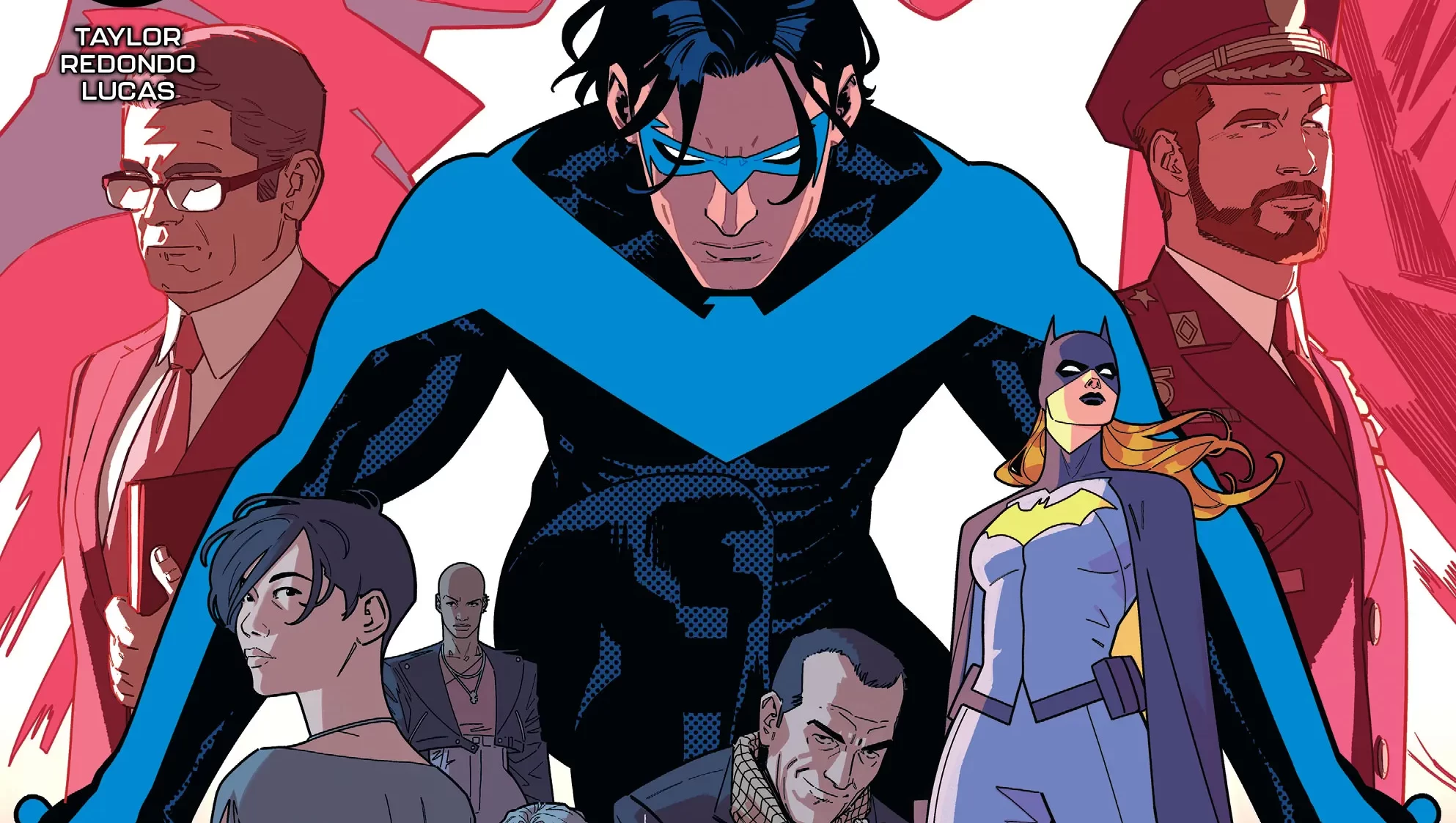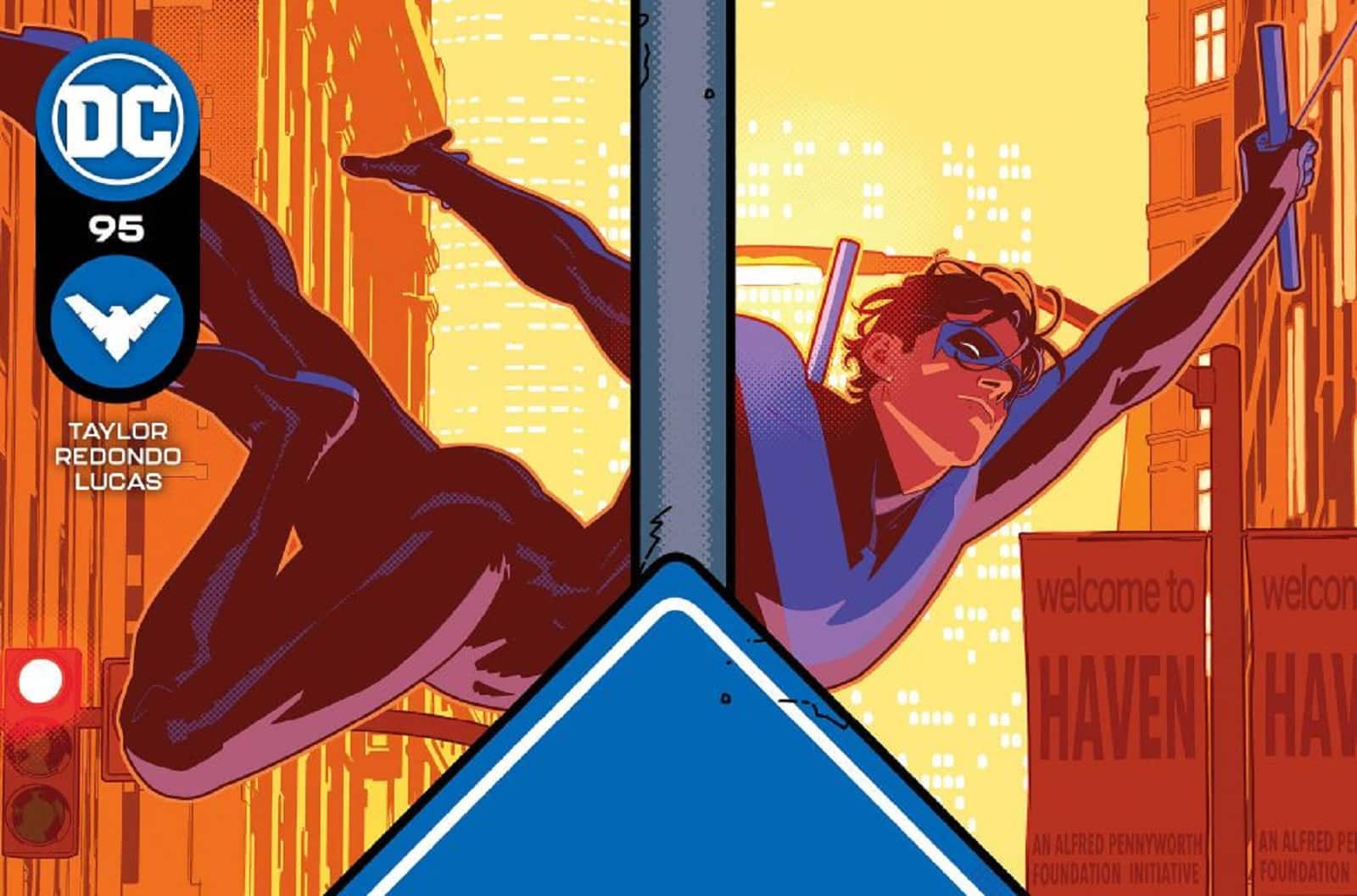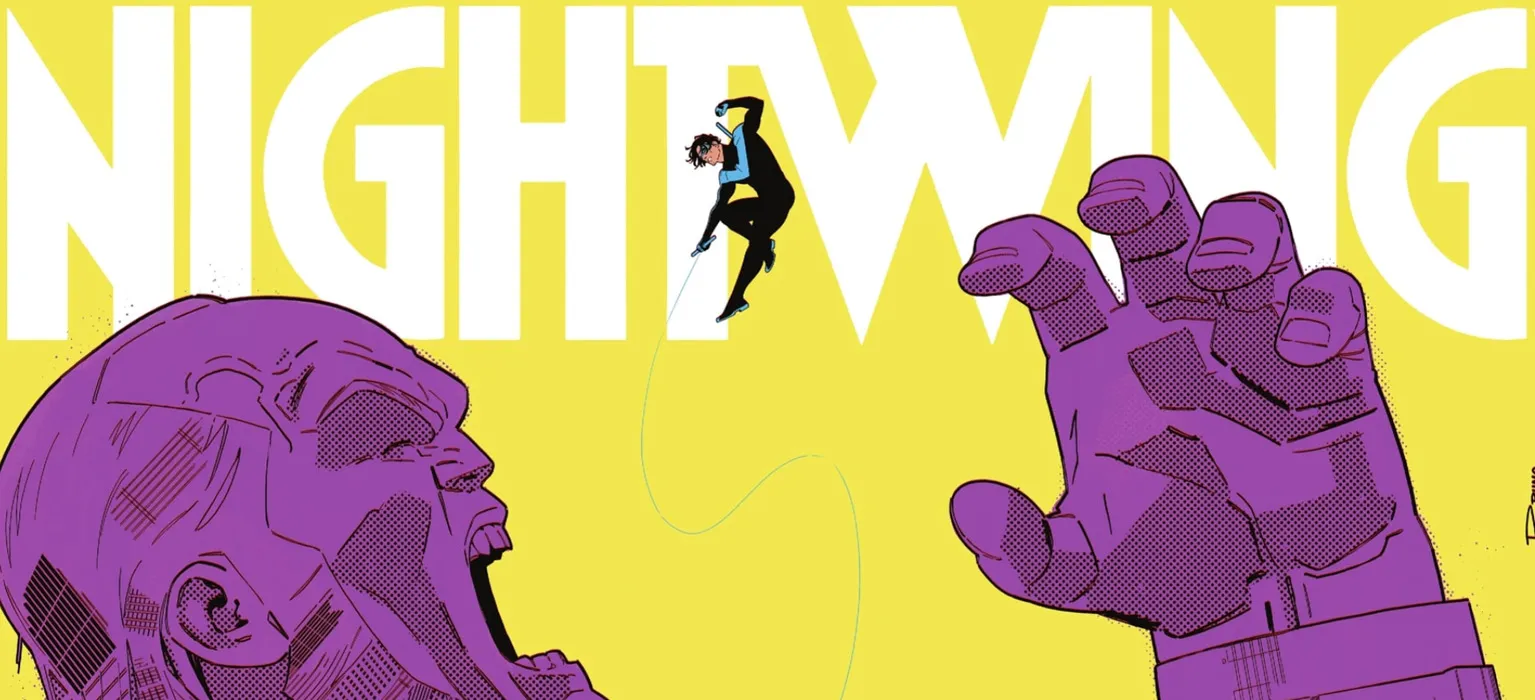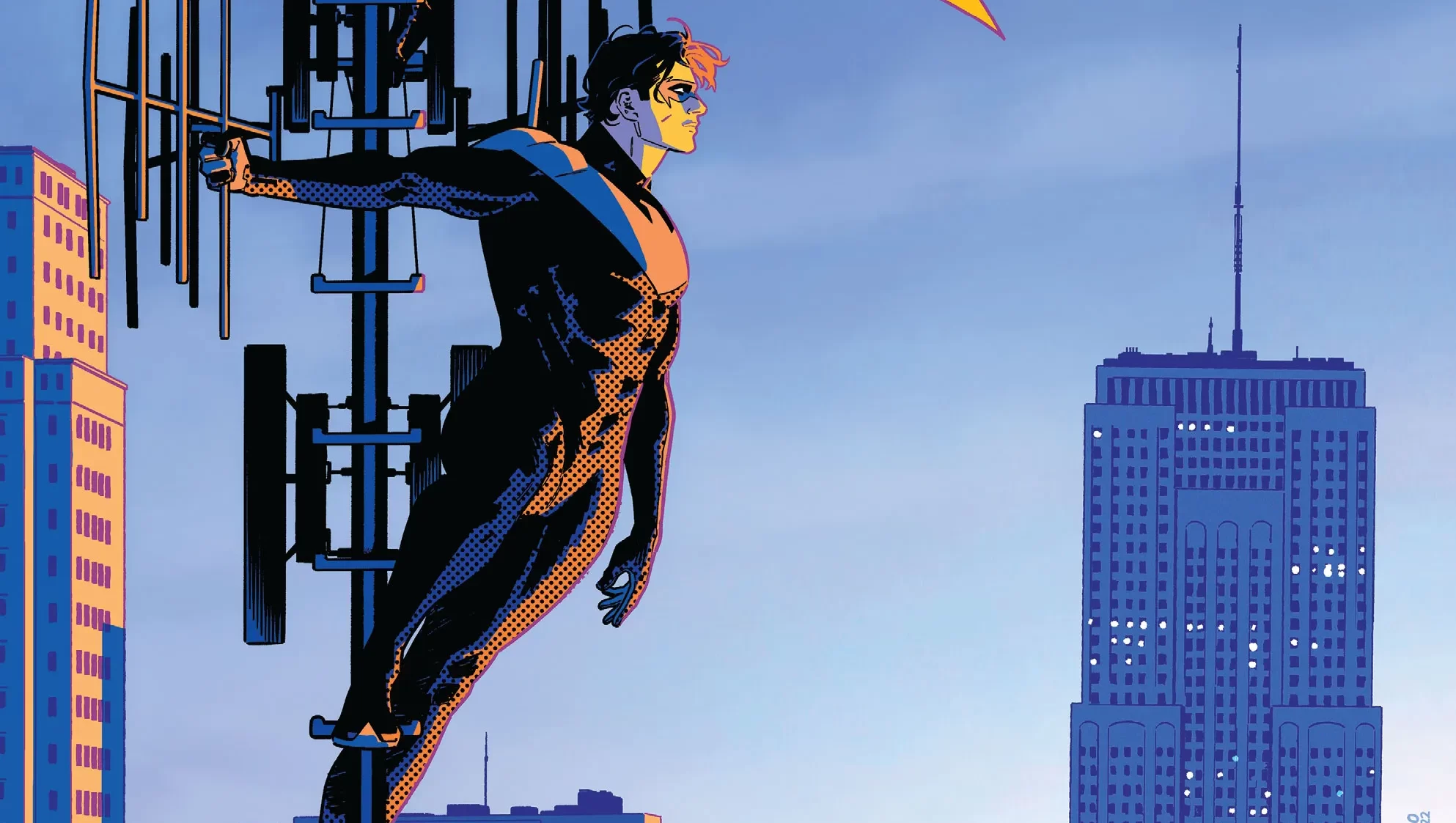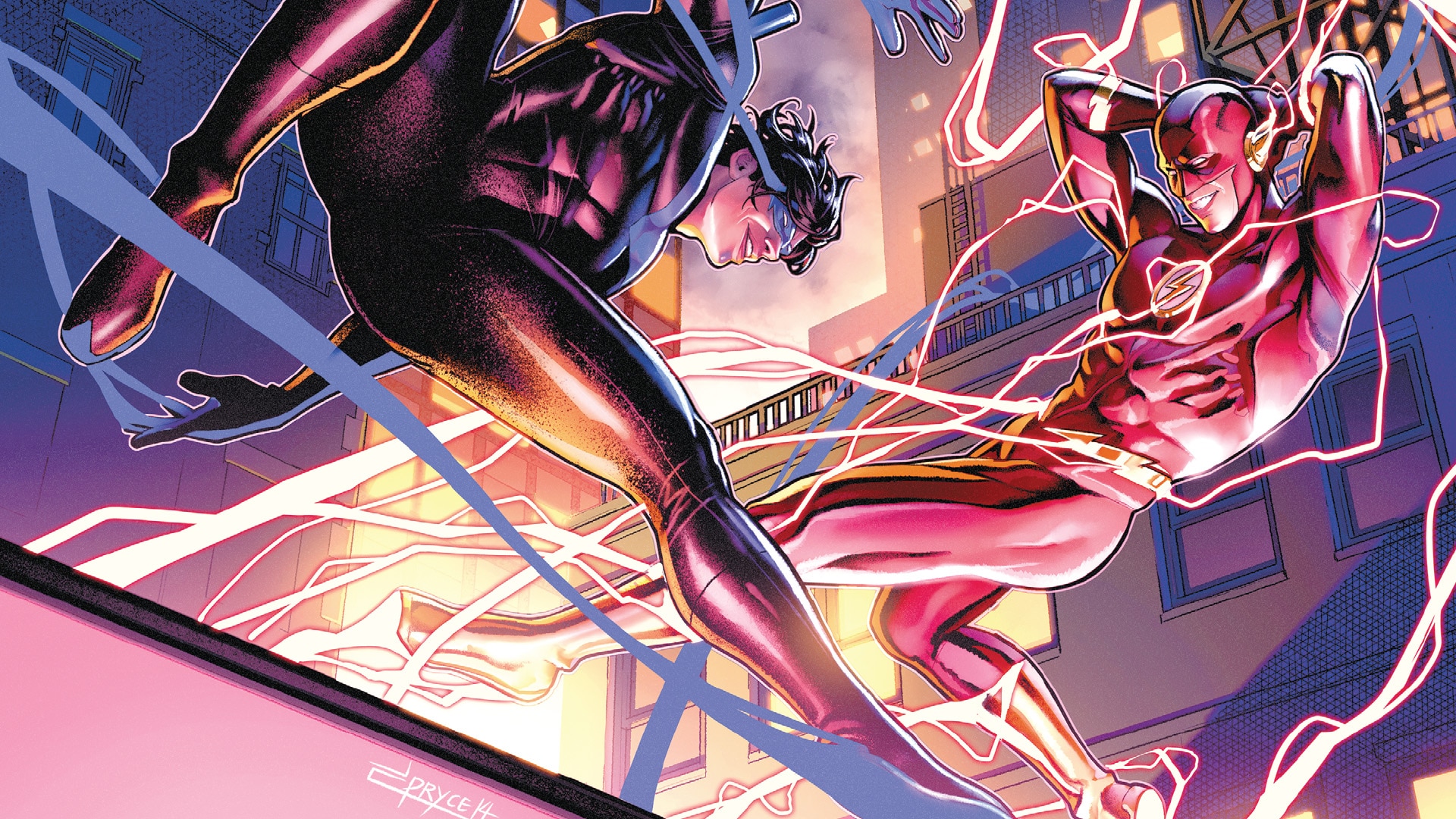Dick Grayson is making waves in Blüdhaven, helping the less fortunate. His latest move is opening Haven, a place that offers free food, free book, and a place to just be, free of judgment. Surely no one could be evil enough to want to tear a place like that down…right? Nightwing #92 is written by Tom Taylor, drawn by Bruno Redondo, colored by Adriano Lucas, and lettered by Wes Abbott.
I want to like things. I work hard at it — keeping an open heart while still carefully curating what I consume so I can give the things I love my full focus, because I will come back to them, over, and over and over again. Sometimes, though, every so often, a creator comes along and makes it really hard for me to be able to do so.
Anyone who’s been reading through my Nightwing reviews can see I’ve liked this run more than I’ve had problems with it. When it’s good, it soars, it is a delight of playfulness and a candybag of gags. It’s playful, heartwarming, it’s silly, and it makes you believe a man can – if not fly – swing around a city with little grappling hook sticks and only really come to harm when dramatically appropriate, and look great while doing so. The moments that ruin it, though, come at the cost of everything that does make it good. I suppose I should get more into the specifics here — Nightwing has a villainy problem.
The focus of this book is on Dick Grayson using his newfound fortune to do good for those less fortunate. His latest venture sees him create the unsubtly named Haven. It’s a place where people are given free food, free books, a free place to just sit and exist without being charged for it (I don’t know about whatever city you’re in, reader, but I’m finding that last bit becoming alarmingly rare), all in the heart of deeply corrupt city that’s more or less run by crime boss Blockbuster.
Blockbuster, you see, is angry about all this do-gooding happening in his city. He’s got the Mayor in his back pocket, miring Dick Grayson’s good deeds in paperwork (although it probably helps that she’s kind of a double agent who’s revealed herself to be Grayson’s long lost sister) He’s hired the world’s most expensive assassins to try and take out Dick Grayson. He’s — and this is a significant step down, really — hired thugs in ski masks to wreck the stalls offering free food, books, and housing. Dick Grayson soundly defeats them all, shaming them to boot as he pulls their ski masks off, but throughout the issue I found myself asking…why? Why does Blockbuster care about any of this?
It’s not that I don’t believe evil people in power will do everything they can to keep the disenfranchised from getting any of the help they need, and Blockbuster is certainly an evil man. It’s just that we’re not given any motivation beyond the fact that Blockbuster is, well, evil. It’s cartoonishly evil. It’s aimless, directionless evil, and undermines any inspiring thing Nightwing attempts to do, because you can’t take anything seriously when you’re up against something like that. It’s as blatant as the mob boss who stole Nightwing’s puppy, and just as unmotivated. Yes, you fight the good fight against people who steal puppies and burn down homeless shelters, but that doesn’t really give you a lot to admire about the hero doing the fighting, because of course he’d do that. This level of cartoonish villainy makes the villain of this series almost offensively boring, and that would make Nightwing himself dull too, to say nothing of the book…if the art wasn’t so damned good.
We open with a flashback, with the art team’s best take on the Silver Age art. There’s a texture added to the page that gives it a papery feel, even reading digitally, as I do. Dick Grayson, in his Robin-y youth, gets into an inadvisable and overwhelming fight to defend the innocent, against Batman’s explicit orders. Robin takes a hell of a beating, which enrages Batman, but Alfred stands up to the Bat, telling him in no uncertain terms that Dick needs Bruce’s compassion, not his rage. It’s a heck of a moment for Alfred…one that comes at what I feel is a mischaracterization for Bruce, because I can’t imagine him under any circumstances ordering a Robin to just stand down and let people die, no matter how afraid for Robin’s life he was.
Back to the art, though; putting aside the great retro-feel the art Redondo and Lucas bring to the page, I also really enjoy seeing their take on the more classic version of the Batfamily’s costumes. Redondo has such a clean style to his art that really works well for this era, and I wouldn’t mind seeing him and Lucas on the current World’s Finest style of storytelling — all out Silver Age madness.
There are a lot of great moments in this book, art-wise. Some great unflappable Alfred moments. Nightwing in the moonlight, swooping down into a fast paced action scene. The instigation of a riot, panels scattered across a page, crowding into each other, capturing the sheer, petty chaos of it. There were even a few cameos – some, I believe, I may have missed, but seeing George Perez’s smiling face waving at Dick Grayson from a food stall was a hell of a punch to the gut.
The most impactful moment of the story for me, though, was that page reveal bringing Heartless back into the story proper. He’s been in the background so long I forgot he existed, so him suddenly appearing genuinely took me by surprise. Lucas’ colors did a lot of work in creating that sense of shock and awe, too — we go from the simple colors of Blockbuster’s office building, the electric yellows of the light against light blue walls and simple, ordinary paintings, to a hallway filled with the overwhelming glow of vivid pink violence, bodies thrown everywhere, and Heartless staring right down the camera. It gave me chills. This moment has been a long time coming.
I still have no clue what Heartless’ motivations are. It’s possible that they’re exactly as tiresome as Blockbuster’s seeming lack of motivation. For now, though, it was a moment that was much needed in an issue whose main story has been steadily disappointing me. I want to like Nightwing — and I’ll take any excuse to do so, until it disappoints me again.
Armaan is obsessed with the way stories are told. From video games to theater, TTRPGs to comics, he has written for, and about, them all. He will not stop, actually; believe us, we've tried.

